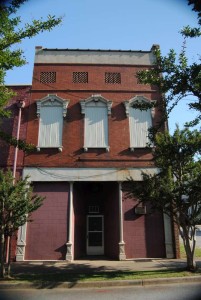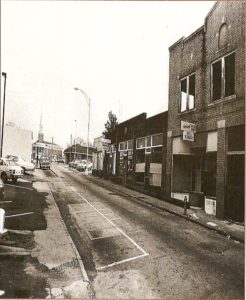Introduction to Church Street

East Church Street Monument before Memorial Park (Brian Scott, 2009)
City Directories and History: 1905 – #111 Warehouse, #114 R.R. Sassard Home, #121 J.W. Thompson (General Repairs),
Church Street was one of the earliest streets in Anderson’s downtown and was a residential street for much of its early history. It was so named because it leads to Anderson’s First Baptist Church. The length of the street has changed. In 1890, it stretched from West Boundary (South Murray Avenue) to East Boundary (South McDuffie Street). By 1918, Church Street ran from Tolly Street in the west, now the main drive of Mimosa Park, to the church in the east. Presently, it stretches west to Tribble Street and east to the church.
Before it became a business district, Church Street was populated with only four homes. Over the next few decades, Church Street saw little growth until the city of Anderson began encouraging African-American businesses in the early 1900’s to set up shop. Businesses began to appear in 1906, including a grocer, a bicycle repair shop, a cobbler, a hotel/boarding house and restaurant, and a paint shop. What resulted was a vibrant African-American business district in downtown Anderson, South Carolina.
Since the mid 1980’s, Church Street has become mostly parking lots, parks, and sidewalks on the blocks between South Murray Avenue and South Main Street, and South Main Street and South McDuffie Street. Sadly, many of the businesses had been abandoned and the buildings were beyond repair. Most of the buildings did not the safety standards of the time, and had to be razed. None of the buildings on East Church Street were listed in the Anderson Downtown Historic District in the National Register of Historic Places.

In Commemoration of Black Pioneers Monument (Brian Scott, 2009)
Gone are the businesses that were once the center of African-American life in downtown Anderson but their memory lingers on. Two small monuments were placed on either end of Church Street to honor the businesses and people of East and West Church. The East Church Street monument was erected in 1982 by the Committee to Commemorate Black Businesses. After several years of planning and development, a new memorial park is scheduled to open in the summer of 2016 on East Church Street in honor of the African-American businesses, and a time capsule will be opened with ceremony on February 14, 2036.
East Church
Like many of the east-west streets that intersect with Anderson’s Main Street, Church is divided into two sides. East Church was the more populated side. From Main to McDuffie, there were nearly a dozen storefronts. The only remaining structures are 105 and 119 East Church Streets. The rest of the buildings on East Church were razed after 1986 to make way for additional downtown parking.

“In Commemoration of Black Pioneers” (Brian Scott, 2012)
According to the East Church Street monument, the following people operated businesses on East Church Street: Dr. N.A. Jenkins, M.D. (1907-1920), Dr. Moses Jenkins, pharmacist (1913-1925), Early Jacob “Jake” Thomas, tailor (1918-1977), Willis Ignatius Peek, mortician (1919-1957), Fred Jackson, mortician (1934-1941), and Arfelton Adger, taxi cab company (1946-1977).
Peek and Jackson were mortuary business pioneers, establishing the first African-American mortuaries in Anderson. The Unity Mortuary in Anderson has a memorial chapel named the Peek-Johnson Memorial Chapel in their memory. Peek was also involved in another business venture on East Church Street. In the same building as his mortuary was a restaurant. In fact, the only thing separating the two businesses was a curtain. Peek was the cook in the restaurant and the mortician in the mortuary, often performing both functions in the same day.
Someone not mentioned in the Pioneers monument was a Dr. Bonner. Known as the “Whistling Dentist,” Dr. Bonner was also known for being very stingy with Novocain. To “help” his patients deal with the resulting pain, he would whistle while he worked.

105 East Church Street (Brian Scott, 2016)
105 East Church Street (c. 1896). One of two remaining structures on East Church Street, and one of the oldest buildings in downtown Anderson. The building first appears in 1896, on the Sanborn map with the name “Sullivan,” indicating that it was an early location of the Sullivan Hardware Company. The Sullivan firm was there until around 1906, when the building was listed as the Anderson Hardware Company. It was an office building in 1911, and by 1918, it housed a pool hall, restaurant, and moving pictures theater. The length of the building has changed: it is currently only half as long as it was in 1918.

Big John’s African-American Entrance (Brian Scott, 2016)
Beside 105 East Church is the south wall of Big John’s a one-time popular restaurant facing South Main. The door shown is the African-American entrance from the days of segregation and the pick-up window used by everyone.
107 East Church Street (c. 1918). First appears in 1918 Sanborn map as a grocery.
109 East Church Street (c. 1918). First appears in 1918 Sanborn map as a cobbler.

East Church Street, c. 1970. Anderson Tailor Shop is the tall brick building in the extreme right of the photo. Anderson First Baptist Church is in the distance. (Trade Street, Anderson County Museum)
110 East Church Street (Anderson Tailor Shop). Final business on East Church Street to close. Last owner/operator was Johnny Williford, a long-time Anderson tailor who passed away in 2008 at the age of 87. With Williford’s passing, the Church Street Business District came to an end.
111 East Church Street (c. 1918). In 1905 listed as a warehouse space. First appears in 1918 Sanborn map as a barber shop. 1909 – A.E. Bohannon
112 East Church Street (Friendly Barber Shop). Barber shop located in building from 1923 to 1980. One of the last two businesses to operate on East Church. The barber shop closed around 2007.
114 East Church Street. Remaining residence on East Church Street in 1918. House was l-shaped with a two-story section and a porch which extended across the entire front. Eventually replaced with storefronts starting with 110. 1909 – Oliver Bolt

Church Street Heritage Park, site of many East Church Street businesses. Expected to be completed August 2016. (Brian Scott, 2016)
115 East Church Street (c. 1896). Undertaker, funeral home. The building first appears in 1896, on the Sanborn map as a grocery warehouse. By 1901, it was a furniture warehouse, and by 1918, it was the mortuary/restaurant operated by Peek. 1909 – Brissey and Stone.
117 East Church Street (c. 1896). The building first appears in 1896 on the Sanborn map as a warehouse.
119 East Church Street (c. 1896). The building first appears in 1896, on the Sanborn map as a warehouse. One of two remaining structures from East Church Street. Building is now part of the Bleckley Inn.
122 East Church Street. Boarding house/hotel; included a restaurant. First appeared in 1918 Sanborn map. The building was a two-story rectangular shaped building with a front porch which extended across the front.
Stay Connected
Explore history, houses, and stories across S.C. Your membership provides you with updates on regional topics, information on historic research, preservation, and monthly feature articles. But remember R&R wants to hear from you and assist in preserving your own family genealogy and memorabilia.
Visit the Southern Queries – Forum to receive assistance in answering questions, discuss genealogy, and enjoy exploring preservation topics with other members. Also listed are several history and genealogical researchers for hire.
User comments welcome — post at the bottom of this page.
Please enjoy this structure and all those listed in Roots and Recall. But remember each is private property. So view them from a distance or from a public area such as the sidewalk or public road.
Do you have information to share and preserve? Family, school, church, or other older photos and stories are welcome. Send them digitally through the “Share Your Story” link, so they too might be posted on Roots and Recall.
Thanks!

